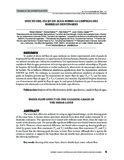| dc.rights.license | http://creativecommons.org/licenses/by-nc-sa/3.0/ve/ | |
| dc.contributor.author | Berríos, Marlyn | |
| dc.contributor.author | Berrios, Dania | |
| dc.contributor.author | Balza, Alirio | |
| dc.contributor.author | López, Juan Carlos | |
| dc.date.accessioned | 2013-04-25T11:56:45Z | |
| dc.date.available | 2013-04-25T11:56:45Z | |
| dc.date.issued | 2013-04-25T11:56:45Z | |
| dc.identifier.issn | 1856-3201 | |
| dc.identifier.uri | http://www.saber.ula.ve/handle/123456789/36960 | |
| dc.description.abstract | Se analizó el efecto del flujo de agua mediante un diseño experimental, sobre el grado de
limpieza del barrillo dentinario, en especímenes de dentina humana obtenida a partir de tres terceros
molares extraídos por indicación ortodóntica. Los especímenes fueron tratados con diferentes
caudales de flujo de agua proveniente de la jeringa agua-aire de una unidad odontológica. El grado
de limpieza del barrillo dentinario se evaluó mediante la observación de microscopio electrónico
de barrido. No se hallaron diferencias estadísticas significativas entre los tratamientos mediante
ANOVA (p> 0.05). Sin embargo, se encontró una mínima diferencia estadística al comparar el
grado de limpieza provisto por los tratamientos de mayor flujo de agua (T4 y T5) con los tratamientos
de menor flujo de agua (T1 y T2). Contrario a la intuición, el grado de limpieza disminuye
con el incremento del caudal de flujo de agua, lo cual apoya la hipótesis de que el mecanismo de
limpieza está relacionado con el fenómeno de la doble capa eléctrica. | es_VE |
| dc.language.iso | es | es_VE |
| dc.rights | info:eu-repo/semantics/openAccess | |
| dc.subject | Limpieza del barrillo dentinario | es_VE |
| dc.subject | Doble capa eléctrica | es_VE |
| dc.subject | Caudal de flujo de agua | es_VE |
| dc.title | Efecto del flujo de agua sobre la limpieza del barrillo dentinario | es_VE |
| dc.title.alternative | Water-flow effect on the cleaning grade of the smear la yer | es_VE |
| dc.type | info:eu-repo/semantics/article | |
| dc.description.abstract1 | The water-flow effect was analyzed, by using an experimental design, on the cleaning grade
of the smear layer, in human dentin specimens obtained from three third molars extracted by orthodontic
indication. The specimens were treated with different water flows, from the water-air
nozzle of the dentistry unit. No statistically significant differences were found between treatments
(p> 0.05). However, a least statistical difference was found when comparing cleaning grade provided
by greater water flow treatments (T4 and T5) with less water flow treatments (T1, and T2).
It was found that the cleaning grade decrease as water flow increase; although this is against the common intuition, it supports the hypothesis that the double layer phenomenon is involved in the cleaning mechanism. | es_VE |
| dc.description.colacion | 5-11 | es_VE |
| dc.description.email | berriosm@ula.ve | es_VE |
| dc.description.email | juanl@ula.ve | es_VE |
| dc.identifier.depositolegal | PP200502ME2052 | |
| dc.subject.facultad | Facultad de Odontología | es_VE |
| dc.subject.keywords | Cleaning of de smear layer | es_VE |
| dc.subject.keywords | Electric double layer | es_VE |
| dc.subject.keywords | Water volume flow | es_VE |
| dc.subject.publicacionelectronica | Revista Odontológica de Los Andes | |
| dc.subject.seccion | Revista Odontológica de Los Andes: Trabajos de Investigación | es_VE |
| dc.subject.thematiccategory | Medicina y Salud | es_VE |
| dc.subject.tipo | Revistas | es_VE |
| dc.type.media | Texto | es_VE |


